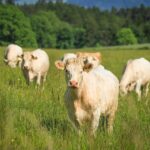Preparing Your Pastures for Fall Planting: Ensuring Winter Grazing Success
go.ncsu.edu/readext?1022924
en Español / em Português
El inglés es el idioma de control de esta página. En la medida en que haya algún conflicto entre la traducción al inglés y la traducción, el inglés prevalece.
Al hacer clic en el enlace de traducción se activa un servicio de traducción gratuito para convertir la página al español. Al igual que con cualquier traducción por Internet, la conversión no es sensible al contexto y puede que no traduzca el texto en su significado original. NC State Extension no garantiza la exactitud del texto traducido. Por favor, tenga en cuenta que algunas aplicaciones y/o servicios pueden no funcionar como se espera cuando se traducen.
Português
Inglês é o idioma de controle desta página. Na medida que haja algum conflito entre o texto original em Inglês e a tradução, o Inglês prevalece.
Ao clicar no link de tradução, um serviço gratuito de tradução será ativado para converter a página para o Português. Como em qualquer tradução pela internet, a conversão não é sensivel ao contexto e pode não ocorrer a tradução para o significado orginal. O serviço de Extensão da Carolina do Norte (NC State Extension) não garante a exatidão do texto traduzido. Por favor, observe que algumas funções ou serviços podem não funcionar como esperado após a tradução.
English
English is the controlling language of this page. To the extent there is any conflict between the English text and the translation, English controls.
Clicking on the translation link activates a free translation service to convert the page to Spanish. As with any Internet translation, the conversion is not context-sensitive and may not translate the text to its original meaning. NC State Extension does not guarantee the accuracy of the translated text. Please note that some applications and/or services may not function as expected when translated.
Collapse ▲
Cow Grazing
As the summer months begin to wind down, it’s time to start thinking ahead to ensure your livestock have enough forage to graze on during the winter. Preparing your pastures for fall planting is a critical step in maintaining a healthy and productive grazing system. Here’s how you can get your pastures ready to plant this fall, ensuring a strong grass yield for the winter months.
1. Assess Pasture Condition
Start by evaluating the current state of your pastures. Check for any signs of overgrazing, soil compaction, or weed infestation. A thorough assessment will help you identify any issues that need to be addressed before planting.
2. Soil Testing and Amendment
Conduct a soil test to determine the pH levels and nutrient content. Fall is the perfect time to amend your soil with lime or fertilizers, as it allows the amendments to fully integrate into the soil before planting. Adjusting the soil pH and nutrient levels will promote optimal seed germination and growth.
3. Select the Right Forage Species
Choose forage species that are well-suited to your area and soil conditions. In many areas, cool-season grasses like ryegrass, fescue, and winter wheat are ideal for fall planting and provide excellent grazing options during the winter months. Make sure to select varieties that are known for their winter hardiness and nutritional value.
4. Prepare the Seedbed
Proper seedbed preparation is crucial for successful pasture establishment. Depending on your current pasture condition, you may need to till the soil to break up compaction, level the ground, and incorporate organic matter. For no-till planting, ensure that the pasture is mowed short, and any existing vegetation is controlled to reduce competition with the new seedlings.
5. Plant at the Right Time
Timing is key when it comes to fall pasture planting. Aim to plant your forage seeds 6-8 weeks before the first expected frost. This gives the grass enough time to establish a strong root system before winter sets in. Be sure to monitor weather conditions and soil moisture levels to ensure successful seed germination and establishment.
6. Manage Grazing Carefully
After planting, it’s important to manage grazing carefully. Newly established pastures are vulnerable, so avoid grazing until the grass is well-rooted and has reached an appropriate height. Implement rotational grazing practices to prevent overgrazing and allow for regrowth.
7. Monitor and Maintain
Throughout the fall and into the winter, keep a close eye on your pastures. Monitor for signs of nutrient deficiencies, pest infestations, or other issues that could affect forage quality. Regular maintenance, such as controlled grazing and weed management, will help ensure that your pasture remains productive through the winter.
Conclusion
By taking the time to properly prepare your pastures for fall planting, you can ensure a steady supply of high-quality forage for your livestock during the winter months. With careful planning and management, your pastures will not only provide essential nutrition for your animals, but also set the stage for a productive growing season in the spring.
If you have any questions please feel free to call the Extension Office at (828) 652-8104 and speak with Skyler Murray.




